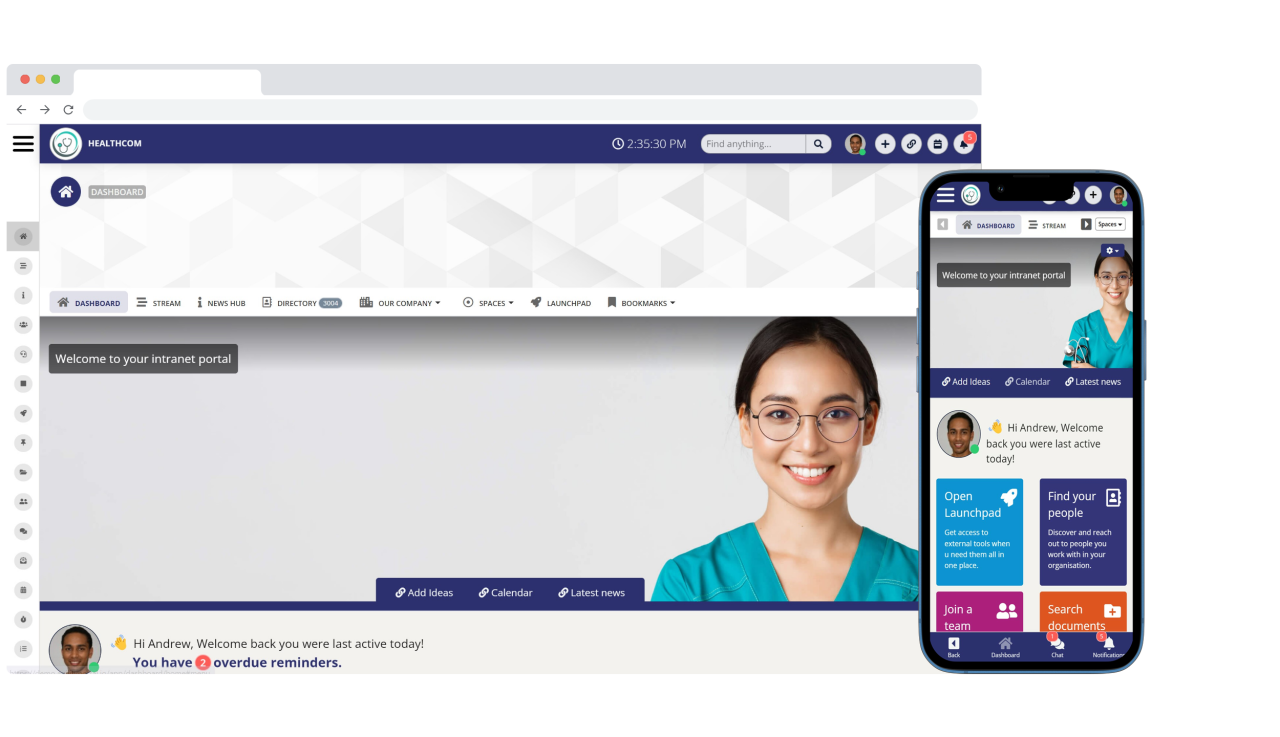Insight Blog
Agility’s perspectives on transforming the employee's experience throughout remote transformation using connected enterprise tools.
10 minutes reading time
(2076 words)
4 Ways to Make Adhoc Meetings Less Damaging to Productivtiy
Maximize team efficiency in ad hoc meetings with AgilityPortal's AI tools and practical, step-by-step management strategies.
Adhoc meetings now play a pivotal role in enabling teams to address pressing issues and make rapid choices. However, without meticulous preparation and execution, these gatherings can derail, resulting in inefficiency and disarray.
This article will present a detailed method for organizing and conducting fruitful adhoc meetings. We'll delve into the criticality and advantages of such meetings and present a structured method for their management.
Prepare to excel in adhoc meetings, enhance your team's productivity, and fully leverage the capabilities of AgilityPortal.
Embark on a journey to convert your unplanned meetings into effective strategy sessions!
What are Ad Hoc Meetings?
Ad hoc meetings, characterized by their spontaneous nature, are unplanned gatherings centered around a specific topic or discussion. Due to their impromptu nature, these meetings lack the luxury of meticulous planning and strategizing.
Therefore, possessing effective strategies for conducting a productive ad hoc meeting is essential to maximize their potential and extract valuable insights.
Having a repertoire of tried-and-true tactics ensures that you can navigate these spontaneous discussions seamlessly, allowing for optimal outcomes even in the absence of prior planning.
When can you have ad hoc meeting?
Ad hoc meetings, spontaneous gatherings summoned without prior planning, serve to promptly address specific issues or topics demanding immediate attention. These meetings prove beneficial in scenarios where swift decisions are imperative or urgent information needs swift dissemination.
Here are instances where calling an ad hoc meeting is warranted:
- To Address an Urgent Issue:
- Critical server outages or system malfunctions
- Customer emergencies or complaints requiring immediate attention
- Safety hazards or potential workplace accidents
- Sudden changes in market conditions or the competitive landscape
- To Make Quick Decisions:
- Approval or rejection of proposals or project plans
- Responding to breaking news or industry developments
- Addressing time-sensitive issues with stakeholders or clients
- To Gather Information or Brainstorm Solutions:
- Seeking input from a team on complex problems or challenges
- Gathering feedback on new products or services
- Brainstorming ideas for marketing campaigns or sales strategies
- To Coordinate Efforts and Align Teams:
- Ensuring everyone is on the same page about a new initiative or project
- Resolving conflicts or disagreements among team members
- Coordinating activities and timelines across different departments
- To Provide Updates or Status Reports:
- Keeping stakeholders informed about progress on critical projects
- Sharing important information about recent developments
- Addressing concerns or questions from team members or clients
- To Resolve a Crisis or Manage a Difficult Situation:
- Responding to public relations crises or negative media attention
- Addressing product recalls or safety issues
- Dealing with natural disasters or emergency situations
In general, the use of ad hoc meetings should be judicious, reserved for situations with a clear and immediate need. Excessive reliance on ad hoc meetings can result in wasted time, unproductive discussions, and employee burnout. When employed thoughtfully, however, ad hoc meetings prove to be a valuable tool for addressing urgent issues, making swift decisions, and maintaining alignment within teams.
Significance of Adhoc Meetings in Business
In the dynamic arena of modern business, adhoc meetings hold immense importance, offering multiple benefits like:
- Prompt Addressing of Unforeseen Challenges: These gatherings empower teams to tackle urgent matters swiftly, ensuring expedient solutions.
- Capitalizing on Immediate Opportunities: Such meetings facilitate rapid decision-making and actions, crucial when immediate opportunities knock.
- Enhancing Team Unity and Collaboration: Adhoc meetings unite team members for brainstorming, sharing insights, and joint problem-solving, bolstering teamwork and a spirit of unity.
Advantages of Adhoc Meetings
Adhoc meetings bring a plethora of benefits, rendering them invaluable in numerous contexts.
- Swift and Dynamic Decision-Making: These gatherings facilitate immediate decisions, unbound by the rigidity of scheduled meetings.
- Enhanced Problem-Solving Efficacy: They offer a concentrated forum for discussing and resolving urgent matters, bypassing unnecessary holdups.
- Stimulating Innovation and Originality: The unplanned aspect of these meetings often ignites novel thoughts, paving the way for groundbreaking ideas and inventive solutions.
With the essentials outlined, let's delve into strategizing an efficacious adhoc meeting.
4 Ways to Improve Productivity of Adhoc Meetings
Follow us and access great exclusive content everyday: Follow us on Google News
1.Preliminary Arrangements: Ad Hoc Meeting Agenda
To guarantee the efficacy of meeting, preliminary planning and ad hoc meeting agendais pivotal. Adhere to these initial steps:
Ascertain Meeting's Aim and Goals
Clearly explain why this unexpected meeting is happening. Set specific goals for what you want to achieve. When picking people to attend, focus on their skills and the value of their ideas. Only invite those who can contribute significantly to the conversation. By selecting carefully, you turn the meeting into a powerful team discussion, not just a gathering of individuals.
Each participant should bring something valuable to the table, ensuring the meeting is productive and results-oriented. Proper planning and thoughtful participant selection are crucial, especially when a meeting comes together quickly.
This approach guarantees a successful and effective meeting.
- Decide on the course of action for a crucial project.
- Eliminate a hindrance preventing progress on a project.
- Engage in dialogue regarding a sudden opportunity, such as a major client selecting your company for proposal submission.
- Conduct a swift retrospective following an unexpected event (e.g., a significant customer issue) to capture insights while they are still fresh.
You may also like: Best Apps for Employees: UPDATED 2022 – A Complete Guide
Circulate the Agenda Early for Optimal Preparation
Share the goals, topics, and expected outcomes of the meeting with everyone involved ahead of time. Use AgilityPortal to sync with business tools, making it easier to schedule and spread information. This early sharing ensures everyone is prepared and knows what the meeting is about.
This helps in efficiently organizing and communicating the details. When people know the agenda in advance, they can come ready to contribute more effectively, leading to a more successful meeting.
2. Establishing Explicit Goals
For ad hoc meetings to yield results, setting unambiguous objectives is essential.
- Formulate Goals that are Specific, Quantifiable, and Realistic: During the meeting, clearly enunciate these aims.
- Share these Goals with All Attendees: It's crucial that each participant comprehends the intended results, aligning their input accordingly.
- Concentrate on Achieving these Outcomes: Consistently revisit the goals during the meeting. This practice helps maintain direction and averts digressions.
Free ebook: How To Get Your Intranet Off The Ground
3. Crafting a Structured Agenda
A meticulously planned agenda serves as the backbone for an ad hoc meeting, providing a clear framework and direction.
- Itemize Discussion Points: Pinpoint critical topics for deliberation. This step involves identifying the key issues that require attention during the meeting.
- Rank Agenda Items by Significance: Organize the points in a sequence, ensuring the most pressing topics are tackled initially. This order helps in addressing vital matters promptly.
- Assign Time Slots to Each Topic: Approximate the duration necessary for each subject. Doing so helps in maintaining a brisk yet thorough pace throughout the meeting.
- Pre-Distribute the Agenda: Ensure that all participants receive the agenda well in advance. This allows team members ample time to prepare, ensuring meaningful and efficient participation.
These steps, when executed properly, create a blueprint for a focused and result-oriented meeting. A well-defined and exhaustive agenda will help team members go into the meeting prepared, clear in mind, ready to contribute towards a successful outcome of this session.
The detailed approach guarantees that every element of the meeting is expected thus taking advantage of the little time available for those crucial conversations.
4. Leading Fruitful Conversations
The success or failure of ad hoc meetings hinges on the caliber of the discussions held inside them.To get desired outcomes, use these techniques:
Promote Active Contribution and Involvement:
- Cultivate a welcoming atmosphere where all participants feel at ease to express their views and insights. Motivate each member to share their thoughts, offering chances for less vocal individuals to articulate their ideas.
- Uphold Respectful and Inclusive Communication
- Establish norms for courteous interaction and attentive listening. Create a space where diverse viewpoints are respected and recognized.
- Maintain Focus on Aims and Agenda
When conversations drift, skillfully steer them back to the central issues. Tactfully realign discussions to correspond with the meeting's intended outcomes.
These strategies are pivotal for nurturing a constructive environment in ad hoc meetings. By encouraging broad participation, ensuring respectful dialogue, and keeping the focus on set objectives, these meetings can be transformed into powerful platforms for collaboration and problem-solving.
This approach guarantees that conversations remain relevant and goal-oriented, maximizing the productivity of the meeting and ensuring that every participant's voice is heard and valued.
The key lies in balancing open dialogue with a clear focus, guiding the group towards effective and actionable outcomes.
Three Principal Challenges (and Solutions) for Adhoc Meetings
Adhoc meetings offer different challenges compared to planned ones. Here are three common problems and practical solutions:
Interruption of Daily Work Routines
Unplanned meetings can interrupt participants' regular work schedules.
To minimize this disruption:
Schedule these meetings in advance whenever possible. Focus on keeping them short and productive. Use a tool for asynchronous communication. This lets team members reply when it suits them. This approach helps balance the need for immediate discussion with respect for everyone's daily tasks. It ensures that these meetings are less of an interruption and more of a productive part of the workday.
Comparatively Lower Productivity
Adhoc meetings often lack structure, leading to chaos that hinders productivity. This disorganization can result in meetings that are unproductive and inefficient.
To boost productivity in these scenarios:
Develop a template for impromptu meeting agendas. Having this template allows for quick organization, ensuring meetings start with a clear direction. Encourage focused discussions. Steering conversations to stay relevant to the agenda prevents time wastage.
Record the meeting details carefully. Accurate documentation is vital, especially when discussions stray from the original plan. This organized approach ensures even unplanned meetings are productive, making the best use of everyone's
Management Challenges
Handling adhoc meetings often results in disarray, affecting overall efficiency and output. The unpredictability of such gatherings can make management arduous, often leading to unproductive outcomes.
To navigate these challenges effectively:
Designate a meeting moderator among the participants. This allows the organizer to concentrate on documenting the proceedings and attending to other critical tasks without the burden of also directing the discussion. Implement an AI-powered tool for automated workflow and recording meeting notes.
Such technology streamlines the process, ensuring important points are captured accurately and tasks are followed up efficiently. This strategy facilitates smoother operation of impromptu meetings, enhancing their effectiveness and minimizing potential chaos.
Maximize Productivity with Effective Meeting Tools
Ad hoc meetings can significantly boost agile teams, providing a platform for addressing urgent matters, generating ideas, and making swift decisions. Following the steps in this guide and using tools like AgilityPortal, you can ensure that your meetings are effective, focused, and lead to practical actions.
AgilityPortal offers an AI-powered assistant, enhancing the efficiency of your adhoc meetings. Coupled with the strategies in this guide, this tool enables your team to make quick decisions, tackle urgent issues, and capitalize on opportunities with greater assurance.
However, it's still crucial to plan, set definite objectives, prepare an agenda, encourage productive conversations, and record important points. Implementing these tactics transforms your ad hoc meetings into invaluable occasions for elevating your team's productivity and collaborative success.
How to have an ad hoc meeting using AgilityPortal
Ad hoc meetings can expedite real-time business decisions, providing a swift resolution without prolonged discussions. However, they also have the potential to be counterproductive, diverting individuals from more impactful tasks.
To optimize the use of ad hoc meetings, adhere to these best practices:
- Establish a singular meeting purpose.
- Develop a concise agenda if time permits.
- Limit meeting duration to under 30 minutes.
- Ensure clear takeaways from each meeting.
- Utilize tools like AgilityPortal's meeting module with Zoom integration for note-taking and recording, offering easy reference when needed (far superior to a standard Zoom meeting, we assure you!).
By implementing these guidelines, you'll enhance the productivity of your ad hoc meetings, contributing to an improved overall meeting and company culture. Best of luck!
Categories
Blog
(2600)
Business Management
(319)
Employee Engagement
(207)
Digital Transformation
(173)
Intranets
(119)
Growth
(118)
Remote Work
(61)
Sales
(48)
Collaboration
(37)
Culture
(29)
Project management
(29)
Customer Experience
(26)
Knowledge Management
(21)
Leadership
(20)
Comparisons
(5)
Ready to learn more? 👍
One platform to optimize, manage and track all of your teams. Your new digital workplace is a click away. 🚀
Free for 14 days, no credit card required.















